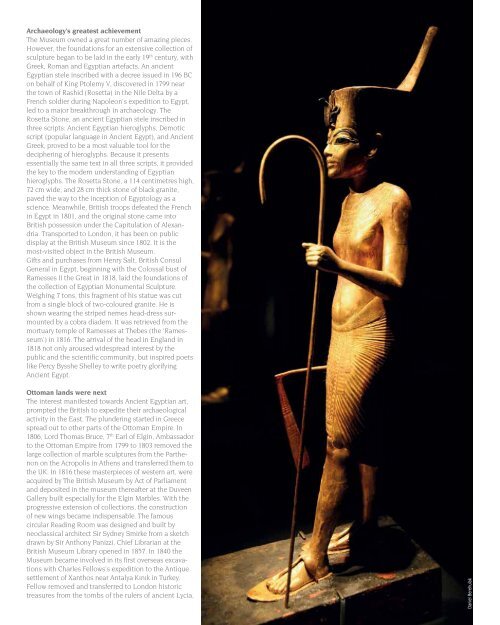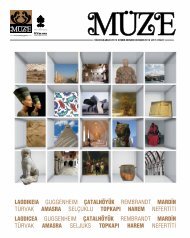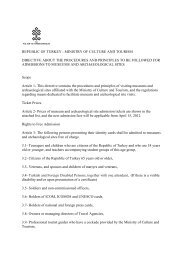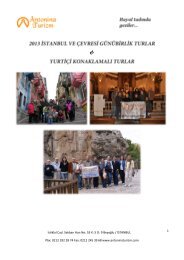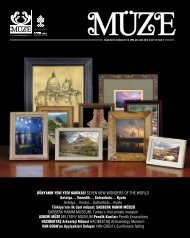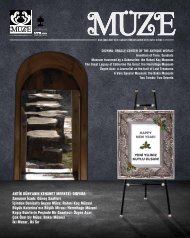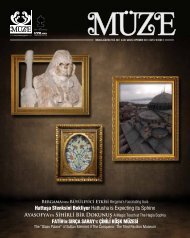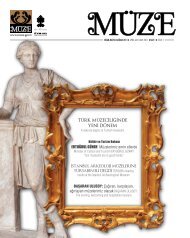GAZİANTEP ZEUGMA MOZAİK MÜZESİ
GAZİANTEP ZEUGMA MOZAİK MÜZESİ
GAZİANTEP ZEUGMA MOZAİK MÜZESİ
Create successful ePaper yourself
Turn your PDF publications into a flip-book with our unique Google optimized e-Paper software.
Archaeology’s greatest achievement<br />
The Museum owned a great number of amazing pieces.<br />
However, the foundations for an extensive collection of<br />
sculpture began to be laid in the early 19 th century, with<br />
Greek, Roman and Egyptian artefacts. An ancient<br />
Egyptian stele inscribed with a decree issued in 196 BC<br />
on behalf of King Ptolemy V, discovered in 1799 near<br />
the town of Rashid (Rosetta) in the Nile Delta by a<br />
French soldier during Napoleon’s expedition to Egypt,<br />
led to a major breakthrough in archaeology. The<br />
Rosetta Stone, an ancient Egyptian stele inscribed in<br />
three scripts: Ancient Egyptian hieroglyphs, Demotic<br />
script (popular language in Ancient Egypt), and Ancient<br />
Greek, proved to be a most valuable tool for the<br />
deciphering of hieroglyphs. Because it presents<br />
essentially the same text in all three scripts, it provided<br />
the key to the modern understanding of Egyptian<br />
hieroglyphs. The Rosetta Stone, a 114 centimetres high,<br />
72 cm wide, and 28 cm thick stone of black granite,<br />
paved the way to the inception of Egyptology as a<br />
science. Meanwhile, British troops defeated the French<br />
in Egypt in 1801, and the original stone came into<br />
British possession under the Capitulation of Alexandria.<br />
Transported to London, it has been on public<br />
display at the British Museum since 1802. It is the<br />
most-visited object in the British Museum.<br />
Gifts and purchases from Henry Salt, British Consul<br />
General in Egypt, beginning with the Colossal bust of<br />
Ramesses II the Great in 1818, laid the foundations of<br />
the collection of Egyptian Monumental Sculpture.<br />
Weighing 7 tons, this fragment of his statue was cut<br />
from a single block of two-coloured granite. He is<br />
shown wearing the striped nemes head-dress surmounted<br />
by a cobra diadem. It was retrieved from the<br />
mortuary temple of Ramesses at Thebes (the ‘Ramesseum’)<br />
in 1816. The arrival of the head in England in<br />
1818 not only aroused widespread interest by the<br />
public and the scientific community, but inspired poets<br />
like Percy Bysshe Shelley to write poetry glorifying<br />
Ancient Egypt.<br />
Ottoman lands were next<br />
The interest manifested towards Ancient Egyptian art,<br />
prompted the British to expedite their archaeological<br />
activity in the East. The plundering started in Greece<br />
spread out to other parts of the Ottoman Empire. In<br />
1806, Lord Thomas Bruce, 7 th Earl of Elgin, Ambassador<br />
to the Ottoman Empire from 1799 to 1803 removed the<br />
large collection of marble sculptures from the Parthenon<br />
on the Acropolis in Athens and transferred them to<br />
the UK. In 1816 these masterpieces of western art, were<br />
acquired by The British Museum by Act of Parliament<br />
and deposited in the museum thereafter at the Duveen<br />
Gallery built especially for the Elgin Marbles. With the<br />
progressive extension of collections, the construction<br />
of new wings became indispensable. The famous<br />
circular Reading Room was designed and built by<br />
neoclassical architect Sir Sydney Smirke from a sketch<br />
drawn by Sir Anthony Panizzi, Chief Librarian at the<br />
British Museum Library opened in 1857. In 1840 the<br />
Museum became involved in its first overseas excavations<br />
with Charles Fellows’s expedition to the Antique<br />
settlement of Xanthos near Antalya Kınık in Turkey.<br />
Fellow removed and transferred to London historic<br />
treasures from the tombs of the rulers of ancient Lycia,<br />
Daniel Berehulak


